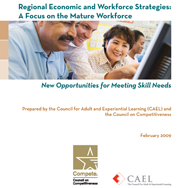Regional Economic and Workforce Strategies: A Focus on the Mature Workforce
Resource type: Research Report
Council for Adult and Experiential Learning and the Council on Competitiveness |
 Mature workers may be one of the most overlooked assets for regions needing skilled workers for economic growth, according to the Council for Adult and Experiential Learning (CAEL) and the Council on Competitiveness. This paper provides a look at representative strategies and programs for regional leaders to consider in helping the mature workers tran
Mature workers may be one of the most overlooked assets for regions needing skilled workers for economic growth, according to the Council for Adult and Experiential Learning (CAEL) and the Council on Competitiveness. This paper provides a look at representative strategies and programs for regional leaders to consider in helping the mature workers tran
 Mature workers may be one of the most overlooked assets for regions needing skilled workers for economic growth, according to the Council for Adult and Experiential Learning (CAEL) and the Council on Competitiveness. This paper provides a look at representative strategies and programs for regional leaders to consider in helping the mature workers transition to jobs that meet their needs and the employers. CAEL is a grantee of The Atlantic Philanthropies.
Mature workers may be one of the most overlooked assets for regions needing skilled workers for economic growth, according to the Council for Adult and Experiential Learning (CAEL) and the Council on Competitiveness. This paper provides a look at representative strategies and programs for regional leaders to consider in helping the mature workers transition to jobs that meet their needs and the employers. CAEL is a grantee of The Atlantic Philanthropies.
Introduction
Regions around the country are grappling with current and anticipated skills shortages and, in some cases, labor shortages. Economic prosperity depends heavily on the quality of the workforce, and yet far too few regions have recognized their best underutilized asset: the mature workforce.
Because mature workers are nearing traditional retirement age, they may not seem to be the obvious target of choice for workforce and economic development strategies. However, many mature workers are, in fact, interested in working past retirement age, either out of financial necessity (particularly given the recent economic downturn) or out of an interest in staying active and involved in the working world.
Mature workers bring many beneficial attributes to the workplace. Employers surveyed by the Center on Aging & Work/Workplace Flexibility at Boston College said that, compared to younger workers, older employees are more likely to have a strong work ethic, are reliable and loyal, have low turnover rates, and have high levels of skills (Pitt-Catsouphes et al 2007). In addition, a recent survey of workers aged 50+ conducted by AARP revealed that they are eager to learn and are particularly receptive to work-related training aimed at improving business and technical skills. The workers also reported that the training had a positive impact on them, including an increased ability to help co-workers, increased productivity, increased job satisfaction, and increased job responsibilities. Mature workers with less education and lower incomes were even more likely than their higher-skilled, higher-paid counterparts to report these training benefits (Towers Perrin 2008).
Mature workers therefore might be one of the most overlooked assets for regions needing skilled workers to support economic growth and innovation, particularly as key industries face skill and/or worker shortages. However, this may be changing. Some regions are beginning to consider how to design workforce training and job placement programs for mature workers, particularly low-skilled mature workers who might be able to advance to higher-skilled, high-demand jobs if offered access to training and education.
This paper by the Council for Adult and Experiential Learning (CAEL) and the Council on Competitiveness provides a look at representative strategies and programs that regional leaders might consider to help the mature workforce transition to jobs that meet the needs of individual workers as well as employers. The paper is part of our Tapping Mature Talent initiative, funded by The Atlantic Philanthropies.
